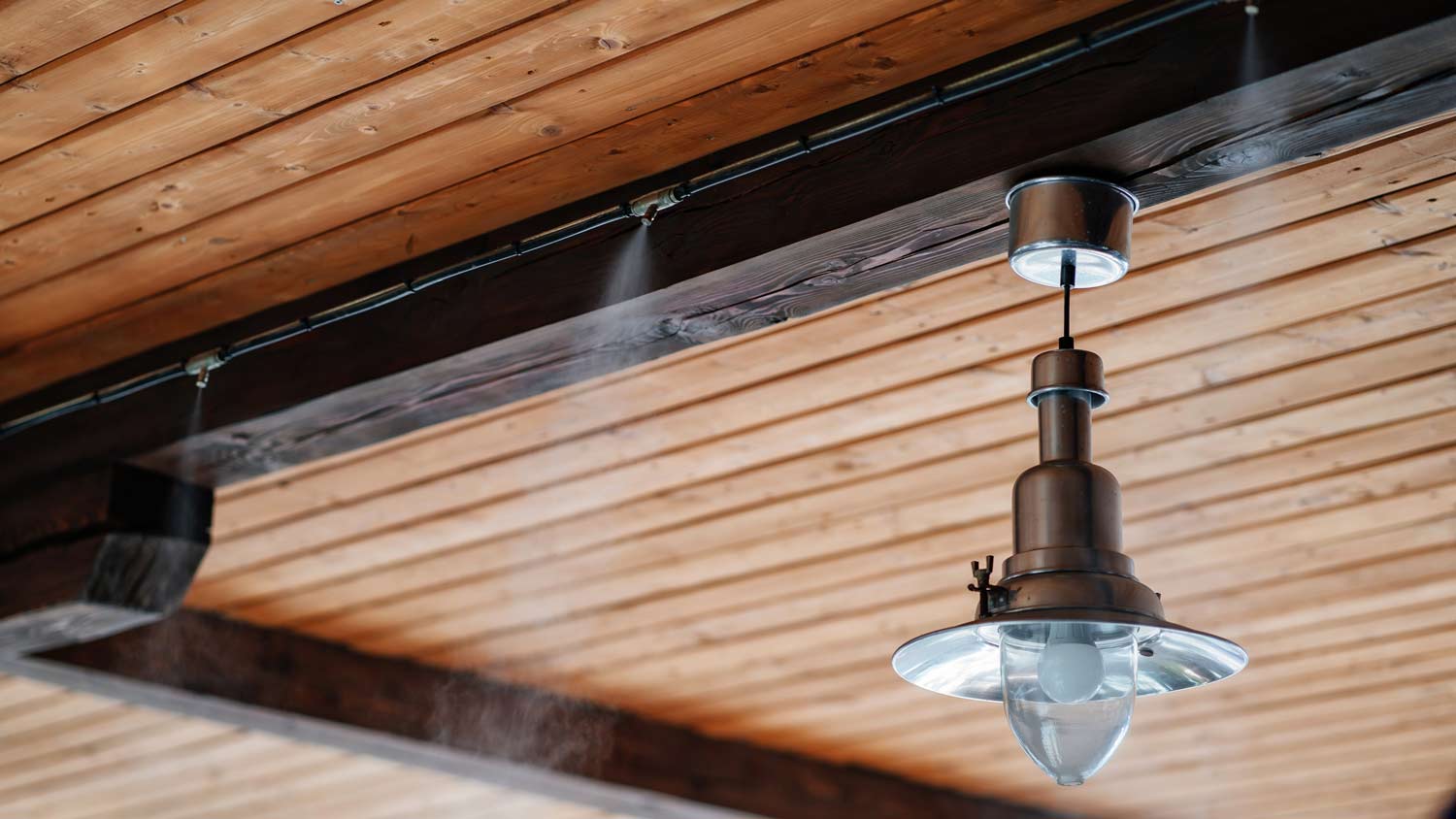
A French drain costs around $9,250 to install, but several factors will determine the final price you pay. Learn the cost to install French drains in this guide.
Learn how these fine-tuned machines keep areas cool without AC


Misting systems produce ultra-fine droplets of water to cool down exterior spaces.
These systems use a pressurized pump to push water through lines and nozzles to create micro-droplets.
These systems can cool down large outside areas by up to 30 degrees Farenheit without air conditioning.
You can install a high-pressure or low-pressure system, depending on your needs.
If you live in or have visited an area with extreme temperatures, you’ve likely encountered a misting system. But how do misting systems work, especially for home-cooling needs?
A misting system is designed to cool down your outdoor areas without soaking everyone with water. Let’s review the ins and outs of misting systems to decide which type works best for your home.
A misting system uses a pressurized pump to push water through special tubing lines, atomizing the water to create fine water droplets that spray into the air. The effect is a light, refreshing mist of water that cools down the area without soaking it (or the people in it) with water. High-pressure misting systems are found in busy public spaces, like zoos or parks, while low-pressure outdoor systems are installed outside homes to keep yards cool during high temperatures.
Although it may seem like magic, misting systems require a few essential items to create the mist that makes even the hottest summers more enjoyable. Most models are hooked up to a water supply fed through a pipe or a hose. A pump in the system then pressurizes the water and pushes it through a series of tubes, which are installed in high places for maximum results.
Once the water travels through the tubes, it hits nozzles that create micro-droplets of water that create a fine mist. After hitting the air, the molecules quickly evaporate, which is why the system doesn’t drench people or objects underneath with water. The evaporation also creates a cooling effect, so that the area with mist is cooler than the actual temperature outside.

If you’re intimidated by the intricacies of installing a misting system, know that their benefits make the details worth learning. Here’s a look at how these systems can add value to your outdoor space.
The main reason people install outdoor misting systems is because it can cool down spaces significantly. Outdoor misting systems can reduce felt outdoor temperatures by 10 to 15 degrees Fahrenheit or up to 30 degrees Fahrenheit in high-humidity areas. Since the mist evaporates quickly once it’s in the air, it leaves the area cooler than the outside temperature and makes eating, relaxing, or socializing outside much more comfortable.
A bonus of installing an outdoor misting system is that it can take care of watering the surrounding plants and vegetation for you. While the occasional use of the misting system won’t replace a watering schedule for thirsty plants, it can spritz your outdoor plant life and provide an extra burst of hydration, especially during hot summer days.
By increasing or decreasing the output of the water molecules, you can control the temperature of the outdoor area surrounding the misting system. If the sun is starting to set and it’s getting chilly on the patio, you can lessen the power of the mist so people don’t get too cold. On the flip side, if the sun is scorching your outdoor dining area, you can increase the mist to make your al fresco meal more tolerable.
If you live in an area with particularly high levels of pesky insects, a misting system can help keep them away from people-populated areas. However, a water misting system differs from a mosquito misting system, which sprays insecticides to eliminate pests.
The main difference between a high pressure and low pressure misting system is that the former uses a heavy-duty pump to create a fog that extends out further to cover a wider area. A low pressure system uses a water hose or faucet to pump out water, and it’s better for smaller areas. Consult a local sprinkler installer to determine which type of system works best for your home based on square footage, climate, and budget.
| Pressure | 800–1,000 PSI | 40–100 PSI |
| Size of Water Droplets | 5–30 microns | 30–80 microns |
| Cooling Ability | Lower by 20–30 degrees Fahrenheit | Lower by 10-20 degrees Fahrenheit |
| Cost | Higher expense | More affordable |
From average costs to expert advice, get all the answers you need to get your job done.

A French drain costs around $9,250 to install, but several factors will determine the final price you pay. Learn the cost to install French drains in this guide.

Discover drip irrigation system cost estimates, key price factors, and ways to save. Get transparent pricing to plan your home irrigation project confidently.

Discover yard drainage cost estimates, including average prices, key cost factors, and tips to help you budget for your yard drainage project.

Putting your sprinkler system to bed for winter will help avoid damage from freezing temperatures. Use this guide to winterize your sprinkler system.

Rain sensors reduce water usage and nourish your lawn naturally. Intrigued? Dig into this guide to learn how to install a rain sensor for your sprinkler system.

Irrigation can help your lawn, flower bed, and veggie gardens thrive. But what is irrigation? Follow this guide to learn how irrigation works.